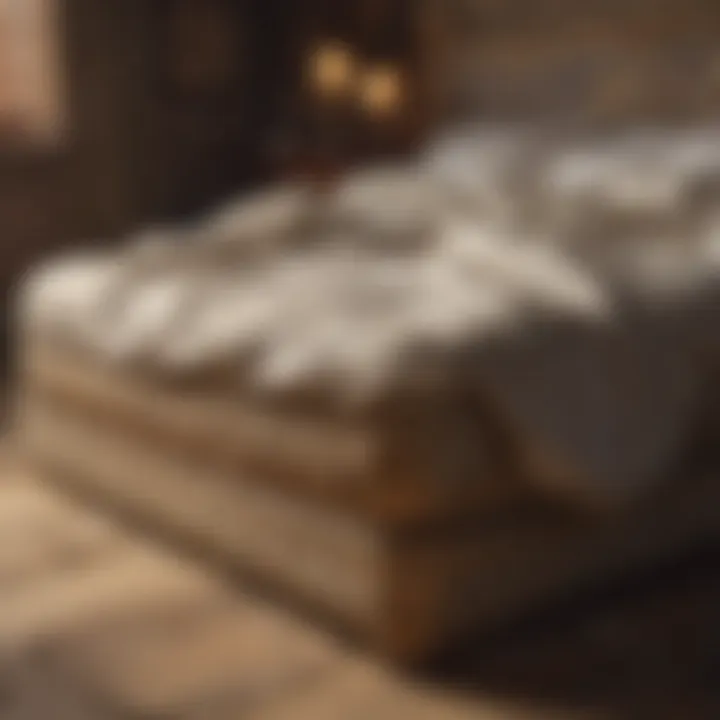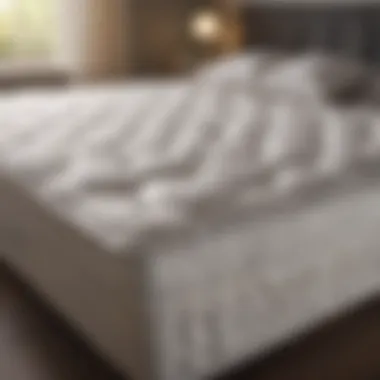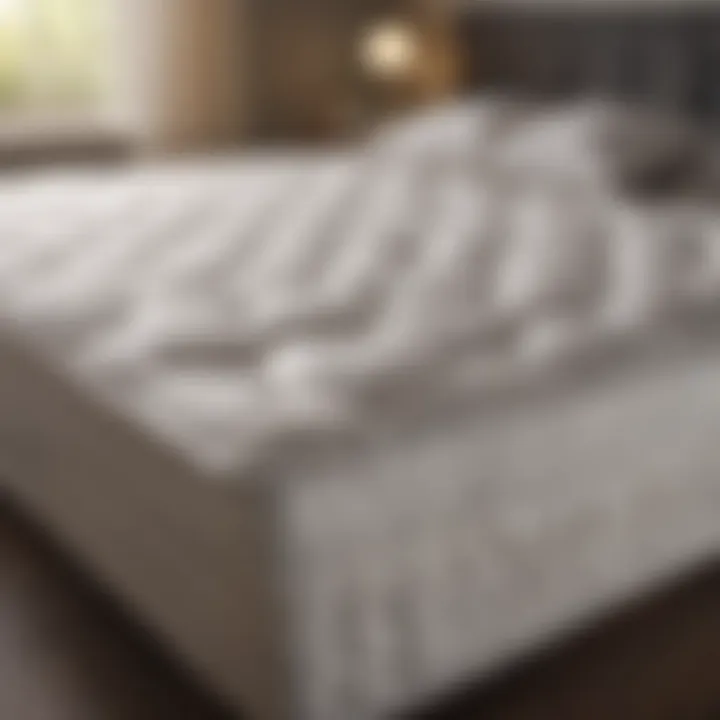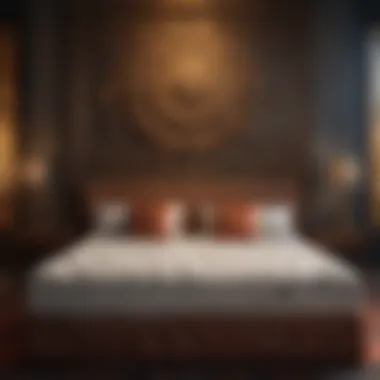The Evolution of Mattresses: A Historical Perspective


Intro
The evolution of mattresses is a fascinating journey that mirrors the changing attitudes toward sleep and comfort throughout history. From simple beddings of animal skins and straw to today's cutting-edge memory foam and adjustable air beds, mattresses have come a long way. As we dive into this narrative, we'll uncover how cultural influences, advancements in materials, and shifts in design aesthetics shaped the sleep comfort of generations past and present.
Understanding the history of mattresses not only sheds light on where we sleep now but also provides insight into our evolving needs as a society. The cozy cocoon we often seek at the end of a long day can be traced back to countless innovations, experimentation with materials, and even an increased awareness of health-related sleep issues.
Trending Styles
Modern Minimalism
In recent years, the minimalist trend has taken the design world by storm, and mattresses are no exception. Sleek lines, no frills, and function-over-form are the hallmarks of modern minimalism. Breezy designs, like the all-foam mattress, encapsulate this ethos beautifully. These mattresses prioritize comfort while sidestepping unnecessary embellishments. With a nod to utility, they serve an essential purpose without overwhelming the bedroom aesthetic.
The rise of eco-friendly materials in this segment speaks to a growing awareness of sustainability. Brands are increasingly using organic cotton, bamboo, and natural latex in their offerings. It's about making choices that serve not just personal comfort but also our planet.
Cozy Rustic
On the other end of the spectrum lies the cozy rustic style. This approach invites warmth and character into sleep spaces, often inspired by cottage charm or country life. Think tufted upholstery and wooden frames paired with sumptuous, down-filled mattresses. It’s a style deeply rooted in nostalgia, tugging at the heartstrings while encouraging restful slumber.
The mattresses in this category often use natural materials that remind one of the peacefulness of a countryside escape. Natural fibers and organic wool contribute to a breathable environment, lending an earthy feel to one’s sleep experience.
"A good mattress is not just about sleep; it's also about creating an atmosphere that makes one feel at home."
Color Palettes
Calming Neutrals
In the realm of mattress colors, calming neutrals have become overwhelmingly popular. Shades of beige, cream, and soft grey dominate the landscape, providing a serene backdrop for restful environments. Neutral colors create a sense of tranquility, encouraging the body and mind to wind down. They blend seamlessly with various decor styles, making them versatile enough to suit any bedroom setting.
Bold Accents
Conversely, some folks are shaking off the shackles of neutrality and opting for bold accents in their bedding choices. Colors like deep navy or rich burgundy can make a statement and draw interest, adding depth to sleepy spaces. These bolder choices often serve as focal points, setting the stage for personal expression amidst the otherwise serene setting of sleep.
In summary, the history of mattresses encapsulates a myriad of trends, from minimalist modern designs to warm rustic charm. As homeowners seek comfort with a touch of style, understanding these evolutions will help in making informed choices that reflect personal tastes and lifestyles.
Prelims to Mattress History
The story of mattresses is more than just a tale of comfort; it reflects our changing needs and cultural evolution over time. As we trace the journey from primitive sleeping surfaces to today's sophisticated sleep systems, we uncover crucial insights into various aspects of life, including health, economic status, and technological progress.
Understanding the history of mattresses enables us to appreciate their significance in our daily routines. From ancient civilizations who used natural materials to enhance sleep, to the production shifts brought by the Industrial Revolution, each era adds depth to the narrative. This exploration is especially relevant today, as health implications associated with sleep have gained more recognition in modern society.
Importance of Surface Comfort
A good night's rest directly contributes to physical and mental well-being. Throughout history, the materials and designs used have gradually evolved to prioritize human comfort. For example, earlier societies needed to adapt their sleeping surfaces based on local resources, leading to the creativity found in cultures worldwide. Understanding this evolution empowers homeowners and housewives alike to make informed choices about their own sleeping environments, ensuring that they prioritize comfort and health.
Key Elements of Mattress Evolution
- Cultural Influences: Different regions have had unique approaches and innovations in mattress design.
- Material Development: Natural materials transitioned into modern synthetic options, impacting longevity and comfort.
- Technological Advances: The introduction of new technologies has transformed how mattresses are designed and manufactured.
In essence, by delving into the fascinating evolution of mattresses, readers gain insight not just into objects for sleep, but into how they've mirrored human needs and desires throughout history. As we peel back the layers on this topic, we invite you to explore how these elements come together to influence our current landscape of sleep.
Ancient Sleeping Systems
The ancient sleeping systems laid the groundwork for what we consider a bedroom today. These systems were more than just places to rest; they were reflections of the culture, resources, and technology of the time. In this context, we can observe how ancient people adapted to their environments using local materials and how those adaptations influenced future mattress designs. This evolution emphasizes the intimate relationship between sleep and culture throughout history.
Prehistoric Foundations
Natural Materials Used
In the prehistoric era, humans relied on whatever nature provided for sleep. Grass, leaves, and animal hides made up the first makeshift beds. These materials had distinct benefits; for instance, they offered a soft surface that could accommodate the human form better than hard ground. Natural materials were advantageous because they were easily accessible, biodegradable, and perfectly suited for the nomadic lifestyle of early humans.
A key characteristic of these natural fillings was their ability to keep the sleeper somewhat insulated. A thick layer of dried grass, for example, would trap air, offering a bit of warmth. Still, there were limitations; natural materials could attract pests or harbor allergens, presenting a challenge for uninterrupted sleep.
Sleeping on Rough Surfaces
The experience of sleeping on rough surfaces is another intriguing aspect of prehistoric knitting. Early humans often slept on rocky or uneven ground, which provided an element of safety from predators. It was rough and sometimes uncomfortable, yet it brought a sense of grounding. Such surfaces required little to no setup, making them a practical choice for early nomadic living and a precursor to more sophisticated bedding systems.
Yet, sleeping on these surfaces introduced certain drawbacks. Unyielding ground could lead to discomfort or even injury over time. The human body, lacking support, would contour awkwardly, affecting sleep quality. Still, these primitive conditions shaped future developments in sleeping systems.


Ancient Civilizations
Egyptian Innovations
Ancient Egypt presented a fascinating illustration of mattress evolution. The Egyptians were among the first to create elevated sleeping platforms made from wood, adorned with luxurious fabrics. Made from palm fibers or cotton, their fillings provided a notable upgrade from the natural materials previously used. Egyptian innovations in bed design showcased their craftsmanship, emphasizing comfort and status. Scholars even suggest that their use of oils and fragrances infused into the materials promoted a calming sleeping atmosphere.
One unique element of Egyptian mattresses was their decorative aspects, often including intricate carvings. This focus on aesthetics not only made sleeping more appealing but also signaled social status. However, this level of luxury wasn’t available to everyone, leading to a division in sleeping experiences based on wealth.
Roman Contributions
The Romans made substantial contributions to the evolution of mattresses. Taking cues from the Greeks, they started to incorporate different materials for a broader array of mattresses, including feathers and wool. The key characteristic of Roman contributions was their push towards creating more comfortable sleeping systems. Their use of springs and layering truly revolutionized resting experiences.
Their designs also emphasized durability; Roman mattresses were often made with linen or leather, allowing them to stand the test of time. However, the luxurious nature of Roman sleeping systems came at a cost. They were more challenging to maintain and required constant upkeep due to exposure to moisture or pests.
In summary, ancient sleeping systems represent a fascinating chapter in mattress evolution. From the rudimentary sleeping conditions of prehistoric humans to the sophisticated designs of the Egyptians and Romans, the story of mattresses reveals much about our cultural priorities and technological advancements. Understanding these historical landmarks aids in appreciating the comfort we enjoy today.
The Development of Mattress Materials
The significance of mattress materials can’t be stressed enough, as they directly impact comfort, support, and durability. Throughout history, humans have embraced various materials, adapting them to meet the evolving needs for sleep comfort. The choice of mattress materials is not just about luxury; it's about fostering well-being, influencing health, and even determining sleep quality. Each material brings its own set of benefits, challenges, and historical context, shaping how we think about sleep today.
Natural Fillings
Straw and Hay
When we think of natural fillings, straw and hay often come to mind as traditional materials for mattresses. Historically, these two elements were readily available and had the benefit of being cost-effective. Straw is known for its rigidity, offering a firmer support, while the unique characteristic of hay is its softness and comfort. While they might seem rustic, their use represents a simpler life where comfort was found in nature.
Straw, in particular, is favorable for its eco-friendliness. Nowadays, bio-conscious houseowners are starting to recognize its benefits. However, it's not all sunshine and rainbows; straw can be prone to pests and may not provide the same plush experience modern folks crave.
"Straw luxury was once the only sort of luxury available to the average folk. Now? It’s more of a nostalgia!"
Feathers and Down
Feathers and down have long been prized for creating an utterly plush sleeping experience. The premium quality of down offers a certain level of softness that invites relaxation. One of the key characteristics of feathers is their ability to provide warmth without excessive weight, making them a favored choice for many. The unique feature of down is its loftiness, which contributes to effective heat retention.
Yet, while feather and down are popular for their comfort, they do come with their own drawbacks. They require regular maintenance and may not be as good for those with allergies. Still, they symbolize a luxury that resonates with many, enticing housewives and homeowners who value an inviting sleeping environment that feels a bit indulgent.
Synthetic Alternatives
Latex Innovations
Latex innovations have revolutionized the mattress market in breathtaking ways. The material combines durability and support while being gentle on the environment, particularly when sourced from rubber trees. A standout characteristic of latex mattresses is their ability to conform to body shapes while retaining phenomenal bounce, making them an excellent option for couples who share their bed.
Moreover, natural latex offers antihypoallergenic properties, much to the relief of those prone to sensitivities. On the flip side, these mattresses usually come with a heftier price tag and can feel warm due to lesser breathability compared to natural materials. Ultimately, latex innovations are seen as a bridge between the past and future of mattress design.
Memory Foam Popularization
The popularity of memory foam has swept through homes as if it was on a never-ending wave. Its distinctive feature lies in its ability to contour to the sleeper’s body, offering personalized support. This material garnered its fame thanks to its pressure-relieving qualities, which is a godsend for those suffering from achy joints.
However, memory foam can sometimes trap heat, leading to uncomfortable nights for some. Despite this minor drawback, the notion of sinking into a cushiony embrace remains irresistible to many. As memory foam continues to evolve, brands are pushing forward innovative designs that incorporate cooling technologies, marrying comfort with coziness, an essential aspect for today’s discerning consumers.
The evolution of mattress materials reflects both technological advancement and cultural shifts. Each type underscores human creativity in the quest for better sleep, making these choices not just functional, but also part of our daily lives.
Cultural Influences on Mattress Design
Mattress design is not just a function of comfort; it also embodies the values and customs of the cultures that create them. Each society has its unique approach to sleep and rest, often leading to distinct materials, shapes, and styles. The exploration of these cultural influences helps to understand how mattresses have transitioned from necessary items to significant aspects of home decor and personal well-being.
Eastern Perspectives
Futons in Japan
Futons represent a fascinating aspect of Japanese sleeping arrangements. Unlike the traditional western mattress system, a futon consists of a thin mattress that can be rolled up and stored away during the day. This space-saving feature is quite beneficial in smaller living spaces, common in Japan.
What sets futons apart is their ability to provide support while adhering to the body’s natural contours. Made from cotton or synthetic materials, they are often placed on tatami mats, which offer additional cushioning and a breathable surface. The benefit here lies not only in comfort but also in the preservation of floor space, promoting a minimalist lifestyle, highly revered in Japanese culture. However, some may find futons less comfortable for long-term use compared to a regular mattress, especially for those accustomed to more substantial bedding.
"The futon has a unique role in Japanese culture; it is not just a sleeping surface but a part of the daily rhythm of life."
Mat Sheets and Their Uses


Mat sheets are an essential component of traditional sleeping systems across various Eastern cultures, particularly in regions like India, where they are woven from natural fibers. These sheets serve as a protective layer between the sleeper and the surface beneath, offering a measure of comfort while sleeping directly on the ground.
One of the key characteristics of mat sheets is their ventilation properties, which allow for breathability. This feature is particularly beneficial in hot climates, as it helps in regulating body temperature. While mat sheets are usually quite lightweight and easy to handle, they may not provide the plush comfort some might seek for a full night’s rest. Thus, they often complement other bedding elements in cultural sleeping practices, illustrating a harmonious blend with the environment.
Western Developments
Canopy Beds and Luxury
Canopy beds are emblematic of luxury and elegance in historical Western sleeping arrangements. Originating in the Middle Ages, these beds feature four tall posts that extend to a fabric covering above, often draped in sumptuous textiles. This unique design was not solely for aesthetics; it also served practical purposes, such as providing warmth and privacy.
The luxury associated with canopy beds reflects the wealth and status of the owner. Such beds were often found in the homes of nobility and wealthy families, replete with intricate designs and lavish fabrics. This characteristic makes canopy beds a popular choice even today for those wanting to add a touch of grandeur to their sleeping quarters. However, their bulky nature may not fit well in every modern home, posing a challenge for those with minimalist designs.
Industrial Revolution Impact
The Industrial Revolution marked a significant turning point in mattress manufacturing, shifting from handcrafted pieces to mass production. The technological advancements of the era introduced durable materials and innovative designs, making mattresses more accessible to a broader audience.
A key feature of this impact was the introduction of coiled springs, which revolutionized mattress comfort and support. The result was a surge in consumer options, leading to more customization in what people could choose for their sleeping arrangements. While the increased affordability and availability of mattresses positively influenced people's quality of sleep, some might argue that the over-commercialization also led to a reduction in craftsmanship, with mass-produced items lacking the personality and uniqueness of previous handmade alternatives.
Through examining these cultural influences, it's clear that mattress designs have not only served to meet the basic need for sleep but have also become a reflection of the values and lifestyles of the societies that produce them. Understanding this evolution gives us a deeper insight into our modern-day preferences in bedding, showing that comfort is as much about culture as it is about material.
Technological Advances in Mattresses
The world of mattresses has undergone remarkable changes over the years, truly revolutionizing how we experience sleep. The topic of technological advances is crucial in understanding this evolution, pointing to innovations that have enhanced comfort and addressed diverse individual needs. Today's mattresses are not just springs and fabric but intricately designed products that incorporate sophisticated technology to improve sleep quality, health, and wellness.
Early Mechanisms
Spring System Inventions
The inception of the spring mattress traces back to the 19th century. This innovation brought about a seismic shift in sleep comfort. The core characteristic of spring systems is the use of coiled metal springs that respond to pressure. This allows for better support compared to traditional sleeping methods. Why did this became a favorite among consumers? Because the design fosters an even weight distribution, making it easier to sink into the bed without feeling trapped.
A unique feature of the spring system is its ability to offer varying levels of firmness. Different types of spring systems exist, like pocket springs, which move independently, catering to individual body contours. This advantage, however, comes with a flip side. Over time, some springs may wear out or sag, leading to discomfort.
Adjustable Beds Origins
Adjustable beds emerged as a game changer in the mattress market, initially geared towards medical uses. They allowed users to elevate their head or legs, making activities like reading or watching TV easier. A hallmark of adjustable beds is their motorized parts, which enable users to change positions with ease. This adaptability has made them increasingly popular among a wider audience seeking comfort beyond just sleeping.
A defining feature is their ability to tailor the incline, promoting better circulation and accommodating various sleeping positions. However, they often come with a heftier price tag, which can be a consideration for many potential buyers.
Modern Innovations
Smart Mattress Technologies
In the era of IoT, smart mattress technologies have taken root. These high-tech mattresses collect data about sleep patterns and preferences, which can be invaluable for enhancing sleep quality. A key characteristic of smart mattresses is their integration with digital platforms, allowing users to track metrics like sleep duration and quality.
This data-driven approach opens up avenues for personalized sleep solutions, making it a beneficial option for many consumers striving for better health. One unique advantage is the ability to adjust firmness based on your nightly habits. On the downside, the reliance on technology may pose issues for those who prefer simplicity in their sleep setup, alongside the inherent costs associated with these advancements.
Temperature Regulation Features
One of the standout innovations in the mattress realm is temperature regulation. This feature has gained traction as more people report discomfort due to overheating during sleep. The primary characteristic of temperature regulation features is their ability to manage heat dissipation, utilizing materials that either retain or release heat as needed.
These features often include cooling gels or breathable fabrics that enhance airflow, making for a more pleasant resting environment. Many are leaning towards these mattresses for their practical benefit—comfortable sleep throughout the night. Yet, they can come with their own concerns, such as the durability of the cooling components and, similarly to smart mattresses, the higher price point associated with advanced technologies.
"The push for innovation in mattress technology underscores a commitment to not just sleep, but the quality of life associated with it."
In closing, technological advancements in mattresses reveal a fascinating blend of comfort and health-centric designs, paving the way for healthier sleep environments. As materials and methods continue to evolve, the way we approach sleep may very well see further transformative changes.
Market Evolution and Consumer Preferences
The landscape of mattress purchasing has undergone a notable transformation over the years. Not only have preferences shifted, but the entire marketplace has adapted to cater to the ever-changing desires of consumers. This section delves into some of those evolving dynamics, showcasing the compelling interplay between technology, consumer knowledge, and market strategies.
Shifts in Advertising and Trends
As the mattress industry evolved, so did its marketing strategies. Companies began to realize that simply offering a product wouldn't cut it anymore. They needed to communicate directly with consumers, which ultimately led to a revolution in how mattresses are advertised.
Marketing Strategies
In the mattress world, targeted advertising has taken center stage. It's essential for brands to understand their audience. A key characteristic of these strategies is their focus on emotional appeal, primarily tapping into the fundamental human need for comfort and rest. This approach is not merely an effective choice; it’s become a vital aspect of modern marketing in the sleep sector.


One unique feature of these marketing strategies includes the development of unique brand narratives. Creating a story around a product has become crucial. For instance, brands emphasize their commitment to sustainability or craftsmanship, helping to establish a more intimate connection with potential buyers. However, the downside can often be potential over-promising—when expectations exceed reality, consumer trust can dwindle.
Influencer Impact
Influencer marketing emerged as another strong motivator in the consumer's mattress choice. Influencers possess the ability to sway opinions through relatable content and personal reviews. This modern takes on advertising has become particularly relevant in the realm of sleep systems. A key characteristic here is the power of trust that these figures have built with their audiences over the years.
Influencer impact allows brands to showcase their products in a more authentic context—there's nothing like seeing a beloved influencer drifting off on a new mattress, right? Yet, with this approach comes the risk of skepticism; some consumers might question the authenticity of these endorsements, pondering whether they are genuine or merely product placements.
Current Trends in Mattress Selection
As consumer preferences shift, mattress selection reflects broader societal movements, especially regarding environmental consciousness and personalized comfort needs.
Eco-Friendly Options
The rise of eco-friendliness is palpable in the marketplace. Consumers are striving to make choices that not only benefit themselves but also the planet. The concept of sustainability is front and center for many shoppers today.
A significant characteristic of eco-friendly options is the use of natural materials such as organic cotton, wool, and biodegradable foams. This aligns closely with the aspirational values of today's homemakers. While these options can be pricier, many believe that investing in a sustainable product is well worth it in the long run, benefiting both their health and the environment. However, potential downsides might include a more limited selection of styles or firmness levels, which could deter some customers.
Customization Demand
The need for personalization continues to grow. Consumers are realizing that sleep is not a one-size-fits-all affair. This is where customization demand comes into play. People gravitate towards brands that offer tailored solutions, such as dual firmness options or adjustable features.
The prominent aspect of customization is its ability to cater to individual needs. A customizable mattress can accommodate various sleep styles, whether you're a back, side, or stomach sleeper. This approach is a successful way to appeal to a diverse customer base looking for a perfect fit. On the flip side, the complexity of offerings may overwhelm some potential buyers, leading to indecision when faced with too many choices.
The Future of Mattress Technology
As we look towards the horizon of mattress technology, it's clear that the next wave of advancements will focus not just on materials but also on environmental sustainability and smart technologies that enhance sleep quality. The future promises not only to improve our sleeping surfaces but also to revolutionize how we perceive rest and rejuvenation.
Sustainability Initiatives
Recyclable Materials
Recyclable materials are gaining prominence in the mattress industry due to their role in reducing waste and promoting eco-friendliness. A key characteristic of recyclable materials is their ability to be repurposed after their lifecycle ends, thus minimizing environmental impact. For instance, companies are now using materials like recycled polyester derived from plastic bottles to produce mattress covers.
This is a popular choice in eco-conscious circles as it supports a circular economy, resulting in less dependence on new resources. The unique feature lies in their production process, which often requires less energy compared to traditional materials. However, a potential disadvantage could be the initial perceptions of quality, as some consumers boldly choose not to prioritize sustainability over luxury comfort.
Biodegradable Products
Biodegradable products represent another significant stride towards responsible manufacturing. These materials break down naturally over time, returning to the earth without leaving a trace. One key characteristic of biodegradable mattresses is the use of natural fibers such as organic cotton or wool, which not only provide comfort but also contribute to sustainability efforts.
This choice is increasingly popular among consumers who consider the planet’s health as part of their purchasing decisions. The unique feature of biodegradable products is their minimal environmental footprint. Nevertheless, some consumers might hesitate due to potential durability concerns, questioning if products made from organic materials will last as long as their synthetic counterparts.
Advances in Comfort and Health
Personalized Comfort Solutions
The future of mattresses won't just cater to the average sleeper but also to individual preferences through personalized comfort solutions. This innovation focuses on tailoring firmness, support, and even temperature to match each sleeper's unique needs. A key characteristic is the integration of various technologies, like adjustable firmness layers, allowing users to modify their bed's feel at any given time.
Such flexibility is beneficial for those with specific comfort requirements tied to body shape or sleeping position. The unique selling point of personalized solutions is the potential to optimize sleep quality and prevent discomfort. However, the complexity of these systems can occasionally lead to higher price points, and not every user may be keen on navigating such technological options.
Health Monitoring Innovations
Health monitoring innovations in mattresses are pushing the boundary of how rest can enhance overall well-being. These mattresses come equipped with sensors that track sleep patterns, heart rates, and possibly even breathing. One key feature is their ability to sync with smartphones or devices, providing insights that can inform better sleep hygiene practices.
This technological advancement is a real game-changer for health-conscious individuals. With real-time feedback, sleepers can adjust their habits for optimal rest. The downside may lie in privacy concerns, as the collection and analysis of personal data can raise eyebrows about security, even as it offers significant insights into one’s health.
"The shift towards mattress innovations isn't merely about comfort—it's about creating a sustainable and health-conscious sleep environment."
In summary, the future of mattress technology pivots around sustainability and personal health, positioning these sleeping surfaces as critical components of our overall wellness routines.
Closure
The journey through the history of mattresses demonstrates the drastic evolution of a necessity often taken for granted. In this article, we've traced the path from primitive sleep surfaces to highly advanced sleep systems. Acknowledging this history sheds light on how cultural influences and technological developments have shaped the choices available today.
One pivotal element to consider is the enduring relationship between comfort and health. As we've seen, early mattress designs often sacrificed comfort for practical necessities. However, modern advancements emphasize creating environments conducive to restful sleep. Innovations such as memory foam and smart technologies not only cater to personal comfort but also aim to promote better health, showcasing how the evolution of mattresses is intertwined with human well-being.
Moreover, sustainability has emerged as a crucial consideration in contemporary mattress design. With an increasing awareness of environmental issues, consumers are gravitating towards eco-friendly options. The shift towards recyclable and biodegradable materials signals a broader trend where choices reflect values beyond mere functionality.
As we ponder the future, it's vital to recognize that innovations will continue to unfold. Future developments promise to further customize the sleep experience and enhance overall comfort. For instance, the integration of health monitoring technologies suggests a future where bedrooms become not merely places to sleep but vital components in our physical health management.
"The evolution of mattresses is not just about better sleep; it’s about understanding our needs and improving our lives."
Ultimately, this exploration underscores an essential takeaway: mattresses are not static items but dynamic products that evolve in response to our changing understanding of rest, health, and our environment. As consumers, being aware of these historical and ongoing trends equips us to make better choices. With informed decisions, we not only enhance our own living conditions but also contribute to a broader shift toward sustainability and health consciousness.















